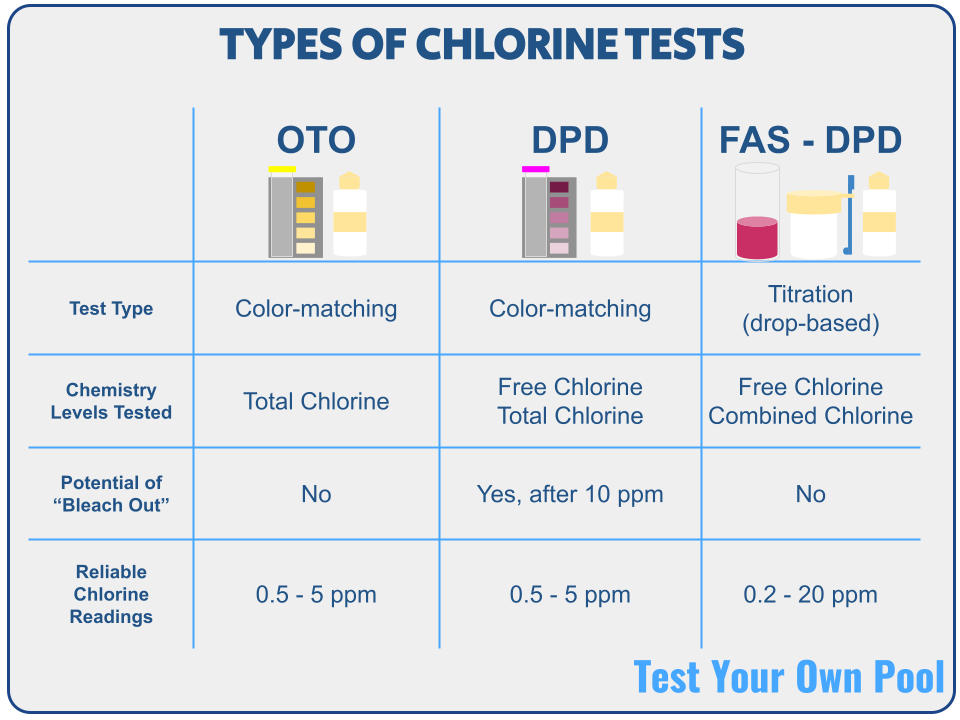Every pool owner should know that maintaining a proper chlorine level is the best way to prevent algae outbreaks and keep your water clear of any contaminants. And, it should be known that the best way to understand those chlorine levels is with a testing kit.
You may not know that different kinds of chlorine tests are widely available.
Depending on the type of kit that was bought, chlorine tests typically come in three different varieties:
- OTO test
- DPD test
- FAS – DPD test
Those are a lot of acronyms that probably are too scientific for anybody to understand. While that may be true, it is important to know the differences between each test. You may be inadvertently under-testing chlorine levels, which can lead to unbalanced water.
What Chlorine Levels Should Be Tested?
Before we get into each test, it is important to understand what is actually being tested. Chlorine is tested through free chlorine (FC) and combined chlorine (CC).
FC is the measure of overall sanitation in the pool that is “freely available” to attack contaminants. CC measures how much sanitation is actively being used to fight the contaminants. CC and FC add together to get total chlorine (TC).
In general, if CC is ever above 0.5 ppm, something in the water needs to be taken care of right away. FC and CC should equal TC.
What is the OTO Test?
OTO stands for Orthotolidine. It has been a chlorine testing method since the 1970s (but can be dated back to 1913!) and is a reliable solution.
The OTO is a color-based liquid test that typically turns a sample yellow if chlorine is present. It can test for chlorine levels from 0.5 ppm to 5 ppm.
However, an OTO test will only test total chlorine levels and is unable to distinguish between free chlorine and combined chlorine. This can prove to be problematic as it is impossible to determine if you need to increase free chlorine or if there are active organisms that the chlorine is fighting. Most health departments across the US have stopped using OTO tests because of this lack of clarity.
The benefit of using OTO is that it is quick and reliable, and the sample will not “bleach out” at higher levels. The sample will start turning reddish-brown to full brown at very high chlorine levels. It is also typically the less expensive of the three. It is a great test if you quickly want to find out if you have chlorine in the water.
What is the DPD Test?
DPD (N, N-diethyl-p-phenylenediamine) differs from OTO tests because DPD tests can establish free chlorine levels. Also used since the 1970s, DPD is another method that utilizes a color-based system and can come in liquid or tablet form. Instead of turning yellow, however, it turns the sample pink.
The DPD test is a two-step process that tests both free chlorine and total chlorine. You can then use TC = FC + CC to determine combined chlorine levels. Tests generally allow readings from 0.5 ppm to 5 ppm
While it can measure all three chlorine levels, DPD testing can be unreliable when reaching 10 ppm and above. Samples can tend to “bleach out” and turn clear, making you believe that there is actually no chlorine present in the water.
What is the FAS-DPD Test?
A variation of DPD, FAS-DPD allows pool owners to measure both free chlorine and combined chlorine directly. This method involves adding a specially formulated DPD powder to a water sample, which reacts with any free chlorine present to produce a distinct pink color, similar to the DPD test.
Where it differs, however, is adding ferrous ammonium sulfate (FAS) drop-by-drop until the pink color is clear and disappears. No color-matching is needed, which is a great solution for users with color vision deficiencies. This level of precision testing can go as low as 0.2 ppm up to 20 ppm, guaranteeing an accurate result each time.
The most accurate and reliable pool testing kit.
Type of Chlorine Test: FAS-DPD
Read our full Taylor K-2006 Review.
This type of testing method is the most accurate but also the most expensive. Also, the drop method can be more time-consuming than the other tests.
Which Test Should I Use?

Each test can serve a purpose in its own right. Perhaps you want to know if you have chlorine present in the water. If that is the case, the OTO will give that answer in about 20 seconds. If you want more control over what is being tested but still get the answer quickly, then a DPD test is for you.
However, if you want to get the full picture that is the most reliable and accurate, the FAS-DPD test is the way to go. To get a little more out of the higher upfront costs, buying a full kit that includes the FAS-DPD test is recommended.
Taylor’s K-2006 Complete FAS-DPD testing kit is just that. It is easily one of the most complete tests allowing you to test every chemical level necessary.
Now that you know, it is time to put it to good use. Keep up the testing, and keep that pool crystal clear!



